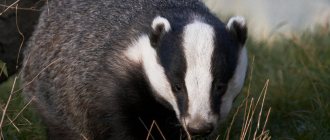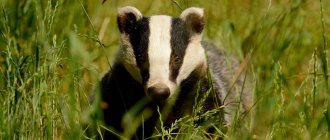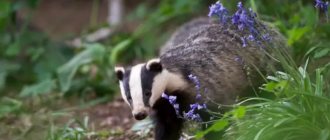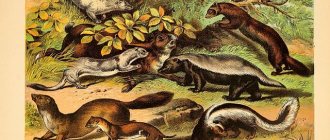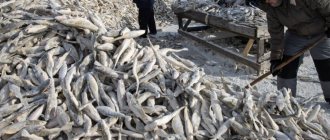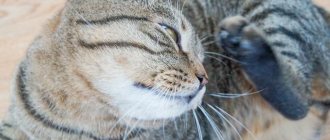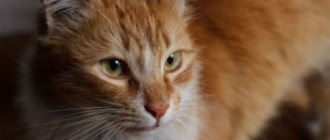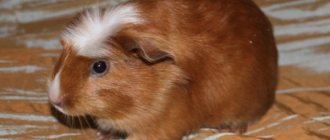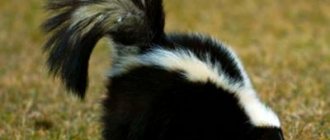Badgers are a genus of small predatory mammals from the mustelidae family. They can be distinguished from other members of the family by their appearance with a characteristic color and rather large size for a mustelid.
According to the International Union for Conservation of Nature, the overall badger population is steadily replenishing and is not causing concern. However, in some regions where these animals were actively hunted, there was a significant decrease in their numbers. In this regard, badgers are included in some regional Red Books, and reserves and sanctuaries are created for their protection.
Characteristics and description of the animal
Japanese
Badgers are nocturnal. During the day they rest in burrows, and at dusk they go out hunting. The predator has excellent hearing and sense of smell, but vision, like many nocturnal animals, is poorly developed. Badgers have a fairly calm and peaceful character. They prefer to avoid danger and only show aggression in extreme cases.
Badgers form pairs or small groups. In places where the density of animals is high, they live in numerous families, living in one burrow with many chambers and underground passages. Predators are attached to their territory and change their habitat only in extreme cases. The same hole can serve as a refuge for many generations. Animals are constantly busy cleaning it and adding new tunnels. An old badger hole has a complex multi-tiered structure, with the number of burrows reaching 40-50, and the total length of the passages being 80-100 m or more.
Badgers have anal glands that secrete a sharp and strong-smelling secretion. Animals use it to mark the boundaries of their territory.
What does it look like
The ordinary
appearance of a badger has the following features:
- the body is elongated, the tail is long and covered with hair;
- the head is small, with small rounded ears and small eyes;
- the muzzle is very elongated, the nose is large;
- The hind limbs are slightly longer than the front ones, the skin on the soles is not covered with hair, and the claws are light.
The fur on different parts of the body differs in length and composition: the muzzle and paws are covered with short hairs, a large number of long and coarse guard hairs grow on the back, belly and tail, the undercoat is shorter and softer. Shedding occurs once a year and lasts several months during spring and summer.
A characteristic feature of the appearance of badgers is their color. A darker stripe runs along the upper part of the back of the animals; the sides and belly have a large number of small white inclusions, which creates the impression of a kind of ripples. The head is painted black and white: two black stripes run along the entire muzzle from the nose to the ears, the forehead and cheeks are white.
The badger's body is adapted for an underground lifestyle: its body is low and flattened, its paws are short with well-developed muscles, its claws are small and strong. The animal easily moves through narrow tunnels and is capable of building new passages very quickly. There are known cases when, during an attack by dogs, badgers managed to hide in a hole and cover the passage in the tunnel with earth, completely blocking it.
Dimensions
Asiatic
The body length of adult badgers ranges from 60 to 90 cm, the tail - from 25 to 30 cm.
The average weight of a common badger is 20-25 kg. Asian and Japanese predators weigh less. Body weight largely depends on the season: by the end of autumn, animals accumulate a layer of subcutaneous fat, and by spring they use up all fat reserves. The maximum weight of a badger can reach 30-35 kg.
Sexual dimorphism in all representatives of the genus is weakly expressed; in some regions, females are not inferior to males in size and weight.
How many years do they live
The average life expectancy of badgers is 10-12 years. Animals kept in captivity have every chance of living to an age of 15-16 years or more.
OTTER
Kinds
The following varieties are distinguished in the genus of badgers:
| Type name | Area | Characteristics |
| European badger (or common) | It lives throughout Europe, including the Crimean Peninsula and the northern part of the Arabian Peninsula, the island of Crete. The habitat also extends to Iran and Afghanistan. The exceptions are the northern territories of Norway and Finland. | The common badger has a more distinct pattern on the head, and the fur on the body has a darker gray tint. |
| Asian badger | They are found in the Asian part of Russia (the largest populations of the animal live in the Primorsky and Krasnoyarsk Territories, Altai, Bashkiria, Khanty-Mansi Autonomous Okrug), as well as in China, Mongolia and the Korean Peninsula. | They differ from the ordinary badger in their larger size and lighter color. |
| Japanese badger | Endemic to the Japanese Islands | The color is dominated by brown shades; the mask on the face does not have such clear outlines as that of an ordinary badger |
| American badger | Distributed in southern Canada, throughout the United States, and in northern and central Mexico | The main difference is the light stripe that runs from the end of the nose to the middle of the back. The pattern on the face does not consist of stripes, but of spots. |
| Pig badger | Distributed in the south and southeast of Asia. | It has sparse fur, gray-brown color, tail, hind legs and sides are yellowish. |
Honey badger
The bald badger, or honey badger, also belongs to the mustelid family. It lives in Africa, the Arabian Peninsula and India. Honey badgers are similar in habits to ordinary badgers, but differ from them in color, size and belong to a different genus.
Where do they live?
Badgers are found on all continents of the Northern Hemisphere with the exception of Africa. They can be found in areas with temperate and subtropical climates. Natural areas suitable for badgers include taiga, mixed, mountain and subtropical forests.
Where live
American
The habitual habitat for badgers is forests, where densely wooded areas alternate with copses, ravines and ravines. The predator is also found in steppes and forest-steppes.
Entrances to badger holes are located in dense bushes on forest edges and clearings, on hillsides. Animals prefer to settle on hills near water bodies, choosing dry, well-drained areas that do not freeze in winter.
What do they eat?
The badger is a carnivorous animal, but in comparison with many other predators it is less carnivorous and eats plant foods.
The basis of the badgers' diet consists of mouse-like rodents, small insectivores (moles and shrews), snakes, frogs, insects and their larvae. On occasion, adult animals can attack baby hares, and birds that make nests on the ground willingly eat carrion.
In summer and autumn, the badgers' diet is supplemented with nuts, mushrooms, acorns, berries and the fruits of wild fruit trees. Predators living near human settlements can raid melon fields and melon fields, but the damage caused is insignificant.
Nutrition
Like any representative of the mustelids, the badger is considered a predator, but in fact it is an omnivore. Long-term observations make it possible to clearly indicate what the badger eats.
His menu includes both plant and animal food, but not carrion, which he will not touch even in difficult times of hunger.
Badgers feed on insects, amphibians and reptiles: often lizards, rarely snakes. As soon as the time comes for berries, mushrooms and nuts, he willingly eats them. A badger eats no more than half a kilogram of food per day.
How do they reproduce?
Badgers are considered monogamous animals: after reaching sexual maturity, they form pairs for life. Readiness for reproduction occurs in females at 2-3 years, and in males at 3-4 years.
At the beginning of spring, badgers go through their first, false, rut. During this period, males who have just reached sexual maturity or have lost females can make long journeys in search of a mate.
Mating occurs in the summer months; the start and duration of the mating season depend on the climatic zone and weather conditions. The total duration of pregnancy is about 9 months. The first stage is latent, during which the embryo does not develop. Badger births usually occur in February-March. The female brings from 2 to 6 babies. Cubs are born blind and cannot hear.
The auditory canals and eyes of badger chicks open 3-4 weeks after birth. The first milk teeth erupt at 1.5 months. By three months, the cubs can already eat regular food, and at 4-5 months the female completely stops feeding them milk.
By autumn, young badgers reach the size and weight of adult animals. Before the onset of winter, they prepare burrows for themselves, where they spend the winter until spring.
MEERKAT
Reproduction
The common badger is a monogamous animal. The formed couple remains for the entire time until one of the partners dies. The badger rut begins in spring and ends in summer.
The following spring, the female gives birth to 3-5 cubs, which are blind and absolutely helpless. Pregnancy lasts from 9 to 12 months. For the first three months of life, the only food for badger cubs is mother's milk. Then the parents teach them to hunt, and the children switch to regular food.
Under natural conditions, a badger lives from 10 to 12 years.
How a badger prepares for winter
The animal is the only representative of the mustelid family that hibernates during the winter cold. Badgers begin to prepare for wintering in mid-autumn. They eat actively, gaining several kg of fat in 1-2 months. Some individuals can gain weight before the onset of winter up to 8-10 kg.
Before going into a hole, the badger removes the old bedding, cleans and deepens the holes, throwing out all the garbage and soil near the entrances. During this period, it is very easy to notice traces of the animal’s vital activity and determine which of the holes are occupied.
Before laying down for the winter, the badger drags dry leaves into the chamber and clogs the entrances with earthen plugs.
Typically, the predator hibernates from mid-October to early November, but the timing may vary depending on climatic conditions. The badger hibernates in the hole until mid-March and comes out only after the temperature remains stably above 0 degrees.
Housing
The badger lives in a hole that it builds on its own. He himself renovates his house and updates it every year. This is what the hole of a solitary badger consists of: first an arched entrance, then a tunnel (can go deep into a distance of one to five meters, occasionally up to ten), which leads to the nesting chamber. The nest has a litter of dry grass.
Badgers can live alone or in families. The young, if the food supply allows, will dig a hole for themselves close to the parent. Or they will expand the existing one, digging separate nesting chambers for themselves. Over time, the hole can grow so large that it will no longer be called a hole, but a badger’s fort. This is a whole system of labyrinths, often multi-tiered, complicated by additional entrances and exits, storerooms and dens. However, each animal has its own, single nesting chamber for winter sleep.
Badger settlements on the slopes of ravines are easy to see in winter and difficult in summer, since they are hidden from view by thickets of grass and bushes.
Badgers are reluctant to change their home; most often, one burrow is used for decades by more than one generation. According to scientific research, some badger forts are several thousand years old!
The animal is clean - the badger digs special separate holes for latrines.
Sometimes a badger's hole is occupied by a stranger - a fox or a raccoon dog.
Meaning in nature
Swine
According to biologists, badgers can be considered one of the most active transformers of ecosystems. In places with high population density, animals build entire underground cities with many branched tunnels. Such underground construction affects the soil, the organisms living in it, as well as the species composition of plants. In addition, badgers control the number of small rodents, slugs, caterpillars and other pests. In search of food, predators loosen the top layer of soil, which also has a positive effect on vegetation.
WOMBAT
Interesting facts about badgers
- Badgers carry some dangerous diseases for humans and domestic animals: rabies, trichinosis, bovine tuberculosis and others.
- The Sunda stink badger, also known as the teledu, was assigned to the skunk family at the end of the last century. The animal received its name for its ability to release a sharp-smelling secretion from the anal glands in case of danger. Together with the Plavan badger they form a genus of stinking badgers.
- The fat accumulated by the badger before the onset of cold weather has a rich composition and has a number of medicinal properties. In folk medicine, badger fat was used to strengthen the immune system, treat colds, various pulmonary diseases, and quickly heal wounds. Residents of the Far East and Siberia applied it to their skin to protect against chapping and frostbite.
- Badgers exchange information with their relatives using many different sounds: from whistles and squeaks to grunts and purrs. When danger approaches, the animal screams abruptly, and during an attack begins to squeal piercingly.
- Breeding badgers in captivity is becoming increasingly popular in private and private farms. Animals are raised to produce valuable fat and meat, which is highly palatable and considered healthy.
Relationship with a person
Badgers are hunted for meat extremely rarely. After all, the animal has a rather specific, somewhat repulsive aroma. Dishes prepared from badger meat do not have a very pleasant taste. The fur of the animal also has no commercial value.
Of interest to humans is exclusively badger fat, which is widely used in the treatment of diseases using traditional methods. The study of the beneficial properties of this substance became the reason for organizing farms where they breed animals. These days, raising badgers for fat is a fairly lucrative business. The animals are easy to tame. However, it is difficult for them to get along with dogs, towards which badgers show particular hostility and aggression.
